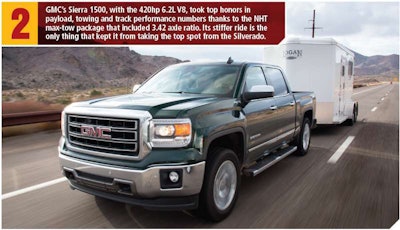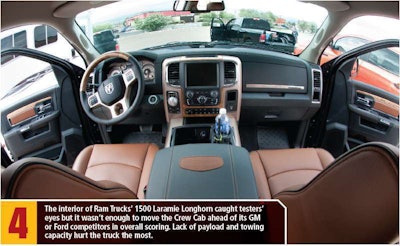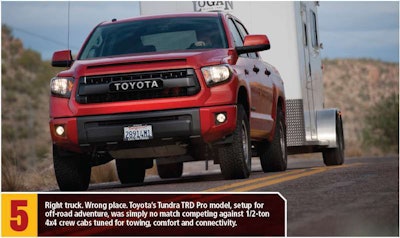
So how do the new half-tons stack up against each other? We were invited to partner with Cars.Com/Pickuptrucks.Com’s test staff on an old-fashioned shootout, comparing similarly-equipped crew-cab 4x4s using a combination of quantitative and qualitative analysis to find the answer.
The number-crunching involved track testing with data gathered via Racelogic data loggers, highway fuel economy and acceleration testing on the 6-percent grade of highway climbing out of Davis Dam in Arizona and votes cast by five automotive writers, including myself.
Scoring was simple: The winner of each of the 11 test categories received 100 points, with the remaining competitors receiving their calculated percentage.
Those empirical categories included: acceleration (loaded/unloaded); braking (loaded/unloaded): fuel economy (empty/towing); payload capacity; towing capacity and other vehicle capability comparisons.
The remainder of the point totals (about 35 percent) consisted of five pickup experts scoring the trucks in six different areas related to ride, handling, ergonomics and other driving factors.
My votes were included with those from freelance automotive journalist David Boldt, Cars.com Road Test Editor Joe Bruzek, MrTruck.com’s Kent Sundling and Mark Williams, editor, PickupTrucks.com.
The total scores were tallied after five days of evaluations that included each judge driving hundreds of miles in each truck (with and without Logan horse trailers loaded to 6,700 pounds in-tow), making multiple passes with each truck down the dragstrip and taking pages of notes.
When the tire smoke cleared a winner appeared by the closest of margins: Chevrolet’s 2015 Silverado 1500 Crew Cab 4×4 LTZ 6.2L. Following closely in total points was GMC’s 6.2L 1500 SLT and third-place Ford’s 5.0L XLT F-150. Ram Trucks’ 1500 Laramie Longhorn and Toyota’s Tundra TRDPro, both running 5.7L V8s, finished fourth and fifth, respectively.
My own subjective evaluation placed the softer-riding and higher-tech 2015 F-150 and plusher Ram Laramie Longhorn ahead of the GMC Sierra.
I felt the Sierra’s heavy-duty towing option made the truck ride far too harsh when it wasn’t burdened with a payload in the bed or with a trailer on the hitch. And, from an interior perspective, it just didn’t stack up against the Silverado, XLT or Longhorn.
But that’s why votes from multiple judges, along with hard track data, helps bring multiple vehicle comparisons to a general consensus.
Here’s a synopsis of how each of the 2015 1/2-ton pickups fared:

1st: Chevrolet Silverado 1500 Z71 LTZ 6.2-liter (1,554 points)
“Although the Silverado did not collect the most points in our 11 empirical tests (the GMC won by just three points), the $54,310 Chevy won five tests outright and placed second in four others,” says Williams, who led the comparison testing.
As dominating as that might sound, the score sheets show it was the judges’ scoring that separated the Silverado 1500 from its competitors: It placed either first or second with four of the five judges, including yours truly.
The single area where the Chevy lost quantitative points was the payload category, because this vehicle was not equipped with GM’s NHT max-tow package as the Sierra 1500 was.
I, like the other judges, felt the Silverado was the best all-around player, doing everything asked of it with ease. And none of the competitors were as quiet on the road or responsive from a power perspective. I noted that the Silverado had the best ride especially when towing, and while not as quick as the Tundra, its engine produced great power at speeds above 50 mph.
The truck’s 6.2L V8 is magical in how strong it pulls and how quickly the 8-speed automatic slams up through the gears when the foot is on the floor during the Davis Dam “hillclimb” and on the dragstrip.

2nd: GMC Sierra 1500 SLT 6.2-liter (1,543 points)
Mechanically there was little difference between the GMC Sierra 1500 in this test compared to the Chevy Silverado 1500. But what differences there were made all the difference in this closely contested comparison.
Of the 11 empirical tests we performed for this comparison, either the Chevy or the GMC won nine. The GMC Sierra 1500 included the NHT max-tow package, which gave the truck a stronger, bigger ring-and-pinion with a lower (3.42) ratio, stiffer suspension and different tires.
The GMC’s lower axle ratio was just enough to give it a little more launching power on the track, and the NHT springs a little less suspension compliance on the road. (The stiffer unladen ride is where the GMC lost valuable points on my scoresheet.)
With the highest GVWR of the lot, quicker acceleration, and other performance factors in its favor, the $54,655 Sierra finished in first place just three points ahead of Chevy in the track performance tests. It’s weakest showing: loaded 60 to 0 mph braking.

3rd: Ford F-150 XLT 5.0-liter (1,509 points)
The new Ford F-150, with the revamped 5.0L V8, is an impressive combination of engineering and smart integration, all wrapped in an aluminum shell. The result is probably the most confident feeling and strongest road cruiser of our test.
“The way the power gets to the wheels and the steering wheel connects to the suspension is simply impressive,” says Williams. I noted that you could tell Ford is targeting towing buyers with its good downhill braking and integrated brake controller.
A point of note: All the F-150s available for testing were technically “pre-production,” meaning Ford could only give us what was available, which is why we got a V8 XLT with “EcoBoost” badging on the side of the truck.
Still, this test truck won two of our tests outright and finished second in two more: A strong showing for the smallest V8 in the group. In addition, the judging group scored the F-150 in first place in the six qualitative categories, showing how well Ford has done on taking the truck’s technology and interior design to the next level.
And it could have done better. The consensus from the judges is the XLT interior trim itself wasn’t nearly as plush or as nicely appointed as those it competed against.
If Ford would have sent a Lariat or King Ranch model, things may have settled out differently.
Still, the $47,845 F150 XLT was judged as being a good value, being the second least expensive truck of the five and missing a second by a mere 34 points.

It’s comparison tests such as this that shine a bright light on technology that’s no longer leading the fast-moving full-size pickup pack. Two years ago the F-150 and Ram 1500 would have been bumper-to-bumper to the finish line. Today, not so much.
The Longhorn edition is one of the nicest interiors, if not the nicest, of the five trucks, receiving high marks from everyone. But the ride of the air suspension and general performance of the 5.7L Hemi just didn’t stand up well against the 6.2L GMs.
Unfortunately for Ram it didn’t stack up against the GMs or Ford in payload, towing , braking or fuel economy, losing valuable scoring points in those areas.
At $54,820, the Ram did the best job of packing in available options to stay under our $55,000 ceiling, but the Longhorn package just wasn’t enough to make up for its perceived weaknesses in the other categories.

5th: Toyota Tundra TRD Pro 5.7-liter (1,295 points)
Here’s the one truck where I felt the manufacturer didn’t put their best foot forward. Toyota’s Tundra TRD Pro is the newest trim package for 2015, and at $45,045 it was the least expensive player in our competition.
But I couldn’t figure out why Toyota would put a truck with a dedicated off-road package (big tires and wheels, softer suspension and durability-first interior) in a competition where towing, load capacity, and a lot of highway driving and track testing were at the forefront. But they did, and it made a good truck look bad.
Toyota’s Tundra has the most legroom in the half-ton class with head-turning exterior looks that appeal to the desert-running off-road crowd.
Painted orange and sitting a couple inches taller than the competitors on off-road tires wrapped around faux bead-lock wheels, it’s the showoff of the five crew cab half-ton 4x4s tested.
But despite its machismo the 2015 Tundra TRD Pro is out of its league competing against half-ton 4×4 crew cabs tuned for towing, comfort and connectivity.









